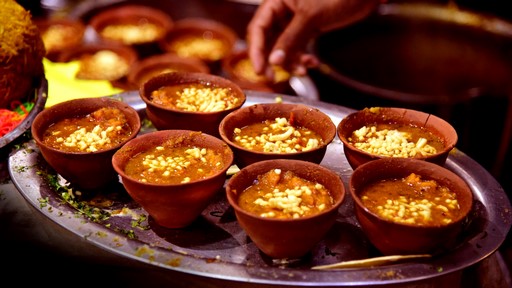
Sorry, we couldn't find anything that matches your search.
Destination

Famous Places to Explore in Hyderabad
A vibrant city with the imposing...

Raipur Tourist Places | Best Place to Visit
The stronghold of several erstwhile...

Ahmedabad
Declared as India's first UNESCO World...
#
Baati Chokha
Varanasi is famous for its baati chokha - a traditional meal popular all across Uttar Pradesh and Bihar. Balls of unleavened bread stuffed with dal (lentils), onions, peas or sattu (powdered roasted gram), are baked on wood fires and eaten with chokha (traditionally made with potato, tomato and roasted aubergine).
It is said that since baati was such a simple dish many freedom fighters like Tantia Tope and Rani Laxmi Bai made it their travel meal. It hardly needed any water and could be baked without a utensil. Moreover, it was packed with nutrients like carbohydrates, calcium, proteins and vitamins.

Lassi
Lassi, a popular yoghurt-based drink is the most pleasing way to end a typical Varanasi breakfast. It is traditionally served in a kullhad (earthen glass) with a thick dollop of cream, often flavoured with rose water and generously garnished with condiments like cardamom. Bhaang, which is cannabis mixed in milk, is also a popular beverage here, especially consumed during the Maha Shivratri festival.

Kachori
This spicy snack is a mainstay of north Indian food and is especially popular in Varanasi. It comprises round flattened balls of fine flour filled with a flavourful filling of dal (lentils) and spices. Kachoris are traditionally served with an accompaniment of spicy chutney. The best place to eat hot and crispy kachoris is Kachori Gali near the Vishwanath Mandir.

Chaat
This savoury snack, a popular hors d'oeuvre all across India, originated in Uttar Pradesh. Varanasi is home to a wide variety of chaats made with a host of ingredients – chopped tomatoes with spices, crispy fried spinach, curd, sev (fried strips of gram flour), sweet tamarind chutney or spicy green chutney.

Banarasi Paan
One cannot truly be said to have visited Varanasi without having tasted the heavenly flavours of the justly famous Banarasi paan. Betel leaf is rolled with areca nut and other condiments to make the lip-smacking paan. Moreover, the makers of the Banarasi paan have refined and elaborated the process to an art form, making it a culinary as well as a visual treat.
To prepare this delicious paan, betel leaves are first cleaned. Then, betel nuts are soaked in water to remove their astringency. The kattha (food additive) is dipped into water and then after a few days, soaked in milk. It is then boiled and left to decant. After sometime, it is tied into clothes and pressed hard to remove its astringency. This kattha is then churned. The tobacco used in the paan is yellow or plain tobacco. All of these steps then culminate to create the delectable Banarasi paan








